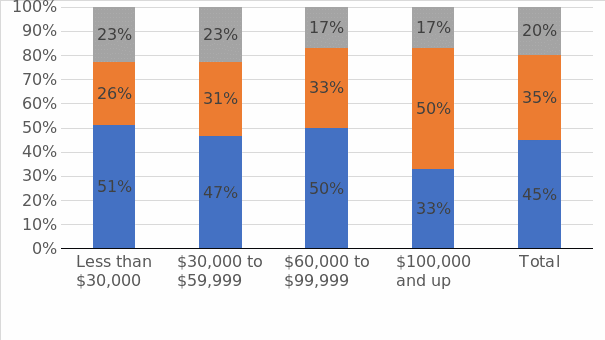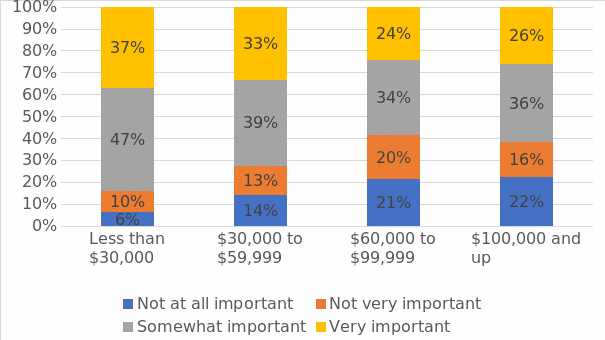Abstract
A longitudinal study conducted by the American Enterprise Institute since July 2020 has tracked how employment conditions, social safety nets, and families have changed over the pandemic. The new Child Tax Credit (CTC) payments launched in July 2021 were the subject of our respondents’ questions in September 2021.Today’s presentation is going to provide the results of the study and discuss the following aspects:
- How recipients have used the CTC payment
- Importance of the Child Tax Credit payments in meeting day-to-day expenses
- Effect of CTC on the employment
- Making the Child Tax Credit expansion permanent
- And answer the question, “Will the Expanded Child Tax Credit Payments Will Keep people from working ?”
Introducing the issue
What is Child Tax Credit, and why is it important? With the CTC, families with children can lessen their tax burden and experience a reduction in increased costs due to their large families. The first CTC payment estimated $400 per child under 17 whiles being non-refundable. This payments program plays a critical role in the US Family Policy, especially due to the last challenges associated with the COVID-19 pandemic. Within the present system, up to $ 3,600 is available for a child under six years of age and up to $ 3,000 for children ages 6 to 17. In addition to this, these funds are fully refundable, and tax refunds can be obtained if the credit overrides the tax. The bill’s authors and the research indicate the following: the CTC reflects the ideological idea of providing as many citizens of the country as possible with the same living standards (Guo & Gilbert, 2014).
Through the American Rescue Plan Act, Congress passed the new payments as a temporary measure, but the process of budget reconciliation could make them permanent as well. President Biden announced on May 17th that his administration would begin sending direct payments to families once a month via the child tax credit as of July 15th. Current policy debates in the United States revolve around recent proposals to extend the Child Tax Credit (CTC).
How Have You Used The CTC Payment (Among Recipients)?
According to our sample (n=1,434), 62 percent of parents received the expanded CTC payments, below the roughly 80 percent of households with children who were eligible. Specifically, the entire payment is available to households with children earning under $150,000 and to households with a sole parent earning less than $75,000.
Twenty percent of these respondents reported using their payments to pay off debt, although less than half of them spent their payments mainly on purchases. CTC payments were more likely to be spent by parents in low-income households, while they were saved by parents in higher-income households.

How Important Have the Child Tax Credit Payments Been in Meeting Your Day-to-Day Expenses (Among Recipients)?

In addition, we asked about the importance of CTC payments for meeting daily expenses. The payments played a smaller role in households with higher incomes than they did in households with lower incomes. The majority of households with an annual income above $100,000 did not consider the payments very important or not at all.
It is unlikely that households will be affected by the new CTC payments in such a short period of time, primarily because the payments are temporarily in place. Still, we can foreshadow how families might change their employment in the long run by asking about their short-term changes. In our survey, we found that some parents have changed jobs due to the CTC payments. Though the vast majority of parents said these new payments had not affected their employment (or their spouse’s employment), there was more than ten percent who said it had. Some parents said this helped them work more, and some said it helped them work less.
In addition, understanding how CTC payments are related to employment needs to be understood more broadly. Parents and non-parents were asked if they were concerned about the expanded CTC payments keeping people from working. A slight majority of moderates and a large majority of conservatives expressed being somewhat or very concerned.
Our survey found that working-age adults were relatively lukewarm on the issue of permanent CTC expansion. The policy received majority support only from those who identify as liberals or somewhat liberal. Only 52 percent of moderate Democrats supported making the CTC expansion permanent.
According to the chart on the slide, the majority of working-age adults identified their political ideology as “moderate” – 51 percent of the sample, compared to 22 percent who identified as very or somewhat liberal. A permanent expansion of the CTC does not enjoy broad political support, as only 43 percent of moderates support it.
Letter to the U.S. Senate
The letter from social workers, social welfare scholars, allied practitioners, and researchers have written to the U.S. Senate explains the need to make the expanded Child Tax Credit permanent and fully refundable.
The letter urges U.S. Senate to keep the expanded CTC permanent for the following reasons:
- A permanent CTC will enhance well-being, especially for the most vulnerable. Over 9 out of 10 American children will benefit from the expanded and fully refundable CTC. Children from low-income families will gain the most.
- It will treat families fairly, regardless of race or ethnicity. Before the recent additions, the CTC benefited White and Asian families disproportionately.
Parents of an estimated 27 million children, including over half of all Black and Latino children and roughly half of all children in rural regions, earned reduced or zero credit under the previous version. Maintaining a fully refundable CTC will help to distribute the credit’s benefits more fairly across children of various ethnicities and socioeconomic levels.
- Making expanded CTC permanent will empower families to make their own choices. Families can use their CTC benefit to pay for the things that are essential to them, such as rent or mortgage payments, school clothes, and supplies, healthy food, or fun after-school activities. Parents say they use their CTC contributions to cover immediate demands and expenses.
- Finally, it will recognize the importance and work of raising children. The enlarged credit acknowledges a truth that all parents know: raising children is labor. By making the CTC available to all families, regardless of present employment, the expanded credit recognizes a truth that all parents know: raising children is work.
Working Class Families Express Concerns about Child Tax Credit
Now we would like to review an article published on Spotlight, which reveals working class families’ concerns regarding child tax credit.
The article emphasizes the opinion of middle-to-low class families on the question of expanding child tax credit and making it permanent. “So, I think it’s important that people in DC be listening to parents who are out there on the ground.” (Brown, 2021).
According to the interviews conducted, the working-class people want their hard work to be rewarded by the current family policies. “They really feel they are playing by the rules and they want an approach to family policy that rewards that.” (Brown, 2021).
The working-class families said that the pandemic had affected their financial status. “The pandemic was such a shock to everybody and a lot of the parents we talked to were very grateful for the checks that they had gotten.” (Brown, 2021). According to the interviews, some people lost their jobs and were looking for more flexible job opportunities.
Conclusion
The Democrats are considering whether to extend the expansion of the Child Tax Credit for another few years in order to make the expanded Child Tax Credit an integral part of US family policy. The expanded CTC payments are intended to help families cover childrearing expenses, but our survey results suggest that they are not targeted well. Many families reported saving the payments or that they were not that important in meeting childrearing expenses. In addition, the results show that most adults oppose the permanent implementation of the CTC, and many are worried that the payments will discourage people from working.
References
What is the child tax credit? (2021). Tax Policy Center. Web.
Guo, J., & Gilbert, N. (2014). Public attitudes toward government responsibility for childcare: The impact of individual characteristics and welfare regimes. Children and Youth Services Review, 44, 82-89. Web.
Goldin, J., Maag, E., & Michelmore, K. (2021). Estimating the Net Fiscal Cost of a Child Tax Credit Expansion (No. w29342). National Bureau of Economic Research.
Brown, P. T. (2021). Working Class Families Express Concerns about Child Tax Credit. Spotlight. Web.
